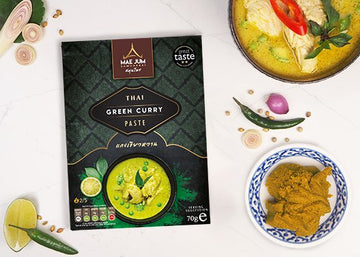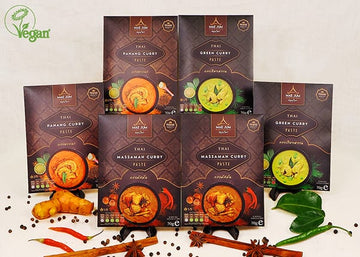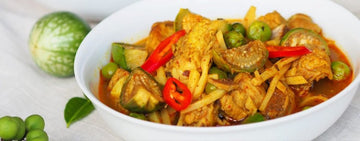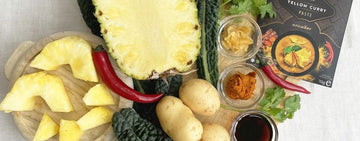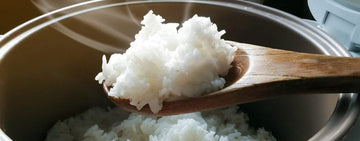Coconut milk has been an integral ingredient in Thai cuisine for thousands of years, adding depth, richness, and a unique tropical flavour to a variety of dishes. However, it only made its way into UK supermarkets about 25 years ago, and even then, the selection was sparse and of rather poor quality. Fast forward to today, and you can easily find a variety of coconut milk brands on supermarket shelves across the UK. But with so many options available, how do you choose the right one for your cooking?
According to Jum, the founder of Mae Jum and a proponent of authentic Thai cooking, the quality of coconut milk can make or break a dish. For generations, her family has relied on coconut milk as a vital ingredient in home-cooked meals, and she insists that no Thai kitchen would be complete without it.

What is Coconut Milk?
One of the most common misconceptions about coconut milk is that it’s the clear liquid found inside the coconut. In reality, that liquid is coconut water, which has a mild, sweet taste and is often consumed as a refreshing drink. Coconut milk, on the other hand, is made from the white flesh of the coconut, which is grated and soaked in hot water, then pressed to extract the milk. This process is somewhat similar to how olive oil is extracted from olives.
The first pressing of the coconut flesh yields a thick, creamy liquid often referred to as coconut cream, which is typically used in desserts or rich sauces. Subsequent pressings produce thinner coconut milk, which is ideal for cooking savoury dishes like curries. The type and quality of coconut milk you find in supermarkets varies depending on the production process, much like the difference between extra virgin olive oil and regular olive oil.
Freshly pressed coconut milk is a staple in Thai kitchens, especially for dishes like Thai Green Curry, where its rich, creamy texture and subtle sweetness complement the spicy, aromatic curry paste. However, as Jum points out, many people mistakenly believe that coconut oil is also a traditional cooking ingredient in Thailand. In reality, Thai cooks rarely use coconut oil for frying or cooking, opting instead for vegetable oil. Instead, the coconut oil that naturally separates from coconut milk during cooking is used to infuse the curry paste with its full flavour, adding a distinct layer of richness and aroma to the dish.
The Importance of Quality in Coconut Milk
One of the key points Jum emphasises is the vast difference in quality between various coconut milk brands, and how this can significantly affect the flavour and texture of your dish. Coconut milk that is high in coconut cream and natural oils produces a rich, creamy dish with that signature ‘glossy’ finish that is essential for authenticity. On the other hand, cheaper brands often include stabilisers and emulsifiers to prevent the natural oils from separating, which not only alters the texture but also diminishes the flavour of the coconut milk.
To achieve an authentic Thai flavour, it’s crucial to choose a coconut milk that allows the natural oil to rise to the surface during cooking. This oil separation is a good thing—it's a sign that you're using a quality product. When cooking, you should see a slight glossiness on the surface of the dish, which indicates that the coconut oil is blending with the curry paste and other ingredients, helping to enhance the overall flavour.
If you're concerned about the amount of oil separating, you can always scoop a little off the top during cooking. But remember, that glossy layer is what gives Thai curries their distinctive, rich texture. If you opt for a brand that doesn’t allow the oil to separate, you’ll end up with a dish that lacks depth, flavour, and authenticity. Our favourite coconut milk is Aroy-D, which you can now buy in large Sainsbury’s, online shops and in stores at international and oriental shops.

The "Lite" Coconut Milk Myth
Many consumers are drawn to cans of coconut milk labelled as "light" or "lite," believing that they offer a healthier, lower-fat alternative. However, this is largely a marketing ploy. The difference in calorie and fat content between light and full-fat coconut milk is minimal, and using light coconut milk can severely compromise the taste and texture of your dish. Authentic Thai curries require the richness of full-fat coconut milk to create the creamy texture and deep flavour that defines the cuisine. Using a light version will result in a thinner, less flavourful dish that doesn’t do justice to the traditional recipe.
Health Benefits of Coconut Milk
Despite some of the concerns about the fat content of coconut milk, it can absolutely be part of a healthy diet. Like many ingredients, coconut milk is best enjoyed in moderation. You’re unlikely to use it in your cooking more than a couple of times a week, and when you do, it will enrich both the flavour and nutritional content of your meal.
Coconut milk is naturally high in several essential vitamins and minerals, making it a nutrient-dense addition to your diet. It contains vitamins B1, B3, B5, B6, C, and E, as well as minerals like iron, magnesium, calcium, sodium, phosphorus, and selenium. These nutrients support various bodily functions, from boosting your immune system to promoting healthy skin and hair.
Additionally, for those who are lactose intolerant, coconut milk provides an excellent dairy-free alternative, allowing you to enjoy creamy dishes without the discomfort. It’s also a popular choice among vegans, not only for its versatility in savoury dishes but also for its use in smoothies, desserts, and dairy-free beverages.
What Does My Body Get from Coconut Milk?
Coconut milk is more than just a delicious addition to your cooking. It is packed with nutrients that can benefit your health in various ways. The vitamins and minerals found in coconut milk contribute to overall wellness, helping to support immune function, energy production, and skin health. Additionally, coconut milk contains medium-chain triglycerides (MCTs), a type of fat that is more easily absorbed and utilised by the body for energy. MCTs have been linked to various health benefits, including improved metabolism and weight management.
Coconuts, in their natural form, are a testament to the bounty of nature. When you crack open a fresh coconut and see its snowy white flesh and clear coconut water, it’s clear that this fruit was meant to nourish and revitalise. Coconut milk captures these benefits, offering a creamy, mildly sweet liquid that not only enhances your cooking but also provides a range of health benefits.

Coconut Milk and Authentic Thai Cuisine
For Jum, and for those passionate about authentic Thai cooking, coconut milk is more than just an ingredient—it’s a vital part of the culinary tradition. Thai dishes are renowned for their complex balance of flavours, and coconut milk plays a crucial role in achieving that harmony. It adds richness and sweetness, balancing the heat from chillies and the acidity from ingredients like lime and tamarind.
But not all coconut milk is created equal. As Jum advises, always check the ingredients label. A quality coconut milk should contain minimal additives. If a can lists a long list of ingredients, including stabilisers, emulsifiers, or preservatives, it’s likely that the product has been heavily processed, and the natural coconut flavour has been compromised.
When preparing a Thai curry, you want the coconut milk to contribute to the overall harmony of the dish, not overpower it or leave it tasting thin and watery. That’s why using the best quality coconut milk is essential. It should be thick enough to provide a creamy texture, but light enough to allow the other ingredients—such as fresh herbs, spices, and vegetables—to shine.
Conclusion: Choosing the Right Coconut Milk for Your Thai Dishes
In the world of Thai cooking, coconut milk is king. It brings together the key elements of Thai cuisine—richness, sweetness, and creaminess—while allowing the other ingredients to take centre stage. Whether you're preparing a fragrant Thai curry, a creamy dessert, or a refreshing smoothie, the quality of your coconut milk will make a significant difference to the final result.
So, the next time you're standing in front of the coconut milk section at your local supermarket, take a moment to read the labels and choose wisely. Look for coconut milk with a high percentage of coconut extract and minimal additives. Avoid “lite” versions if you’re aiming for authenticity, and don’t be afraid to embrace the natural oil that separates during cooking—that’s where the magic happens.
By following these tips and opting for high-quality coconut milk, you’ll be well on your way to creating delicious, authentic Thai dishes that are sure to impress. And remember, cooking with coconut milk isn’t just about making food—it’s about continuing a tradition that has been passed down through generations, celebrating the rich flavours and vibrant culture of Thailand.

If you enjoyed reading the myths of coconut milk, please give this post a rating and subscribe for new blog updates and recipes. Follow and tag us @maejumsamunprai on social media for great foodie content and giveaway competitions! Read more on our blogs today!
